YOU HAVE NO ITEMS IN YOUR CART.
Featured Manufacturers
Columbia Safety and Supply Safety Stand-Down Week 2023: Do you lift, man?
Day Three
Manlift Safety

Whether you’re in construction, maintenance, utilities, or any industry that requires the need to reach high areas in order to perform your job, operating a manlift is a constant daily task. Manlifts, also known as aerial lifts, are an indispensable part of job sites where working off of the ground in areas that a bucket truck cannot access is unavoidable. This frequent work presents a long list of hazards and accident possibilities.
The main causes of injuries and fatalities from manlifts are:
- Falling from heights
- Being struck by the device
- Being struck by falling debris or equipment
- Electrical hazards
Start Your Work Day Right
The beginning of the work day should always begin with an inspection of the equipment. Always reference the specific manlift instruction manual for the proper procedure, but common things to look for are:
- Operating and emergency controls
- Personal protective devices
- Hydraulic, air, pneumatic, fuel, and electrical systems
- Fiberglass and other insulating components
- Missing or unreadable placards, warnings, or operational, instructional, and control markings
- Mechanical fasteners and locking pins
- Cable and wiring harnesses
- Outriggers, stabilizers, and other structures
- Loose or missing parts
- Guardrail systems
- Standard general vehicle maintenance
OSHA Requirements
OSHA establishes mandatory requirements for training and certification for employees working in manlifts in 29 CFR 1910.68. Employees shall be provided training in the various precautions and safe practices described in this section and shall ensure that employees do not engage in the activities in which this section applies until such employees have received proper training.
Fall protection should also always be considered when working in a manlift. While it is rare for an employee to fall from an aerial lift than working in other situations like a pitched roof, it is more common that one could bounce out while operating and manipulating the position of the lift, or if another vehicle hits the lift. While OSHA regulations for fall protection are not crystal clear when it comes to manlifts, once you get more than 6 feet off the ground, personal fall protection is mandated by OSHA’s construction industry standard 1926.501.
Most workers will be wearing typical fall protection equipment. A full body harness, and a shock absorbing lanyard or personal self-retracting device (SRD or SRL).
The current interpretation states that the lanyard in use must prevent the user from freefalling more than 6 feet or from coming into contact with a lower level. There is the option to use a fall restraint system when working in this type of apparatus, which would prevent the worker from moving beyond the height of a top of the lift at all. These fall restraint setups limit mobility within the lift and restrict the reach of the worker while wearing a full body harness. For these reasons, they are not typically used. Finally, a rescue plan should be in place and reviewed prior to any work being done.
Questions or Need More Info?
If you have any questions regarding the above information or need more insight into safety or fall protection in general, reach out to our Gear Experts®! Click here to contact our team, or use the instant chat feature in the lower right hand corner of your browser screen. Also be sure to connect with us on social media to keep up with all of our latest content.














